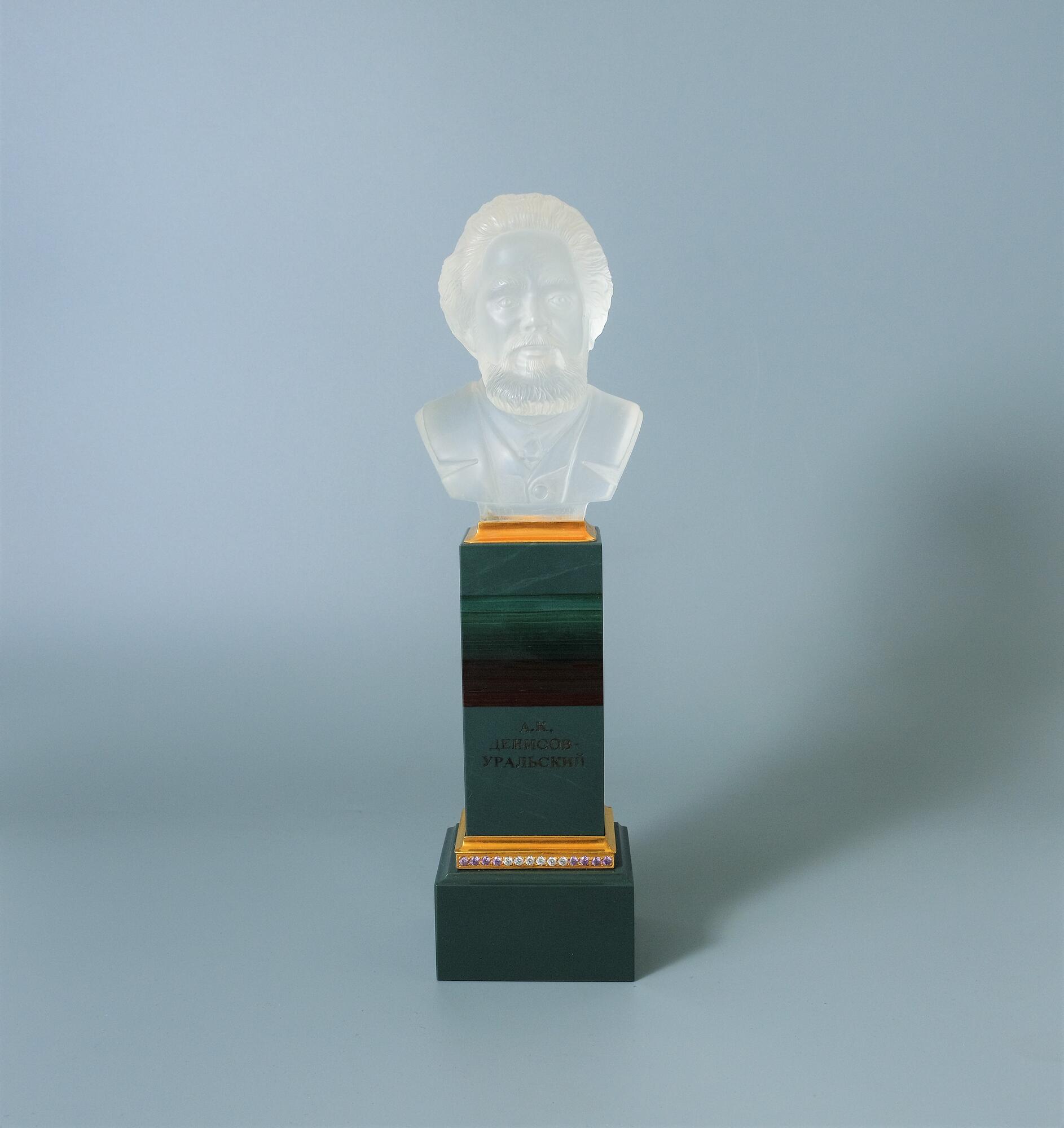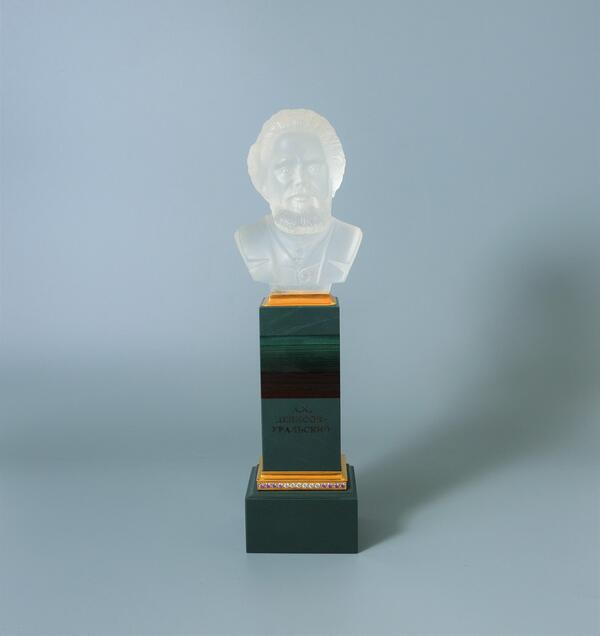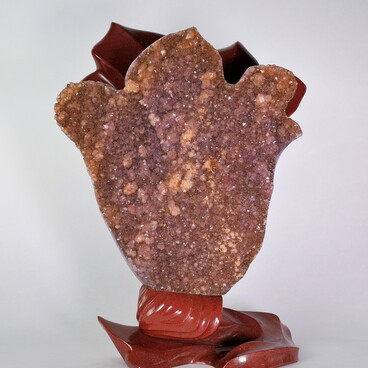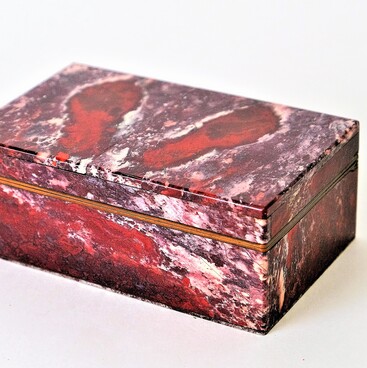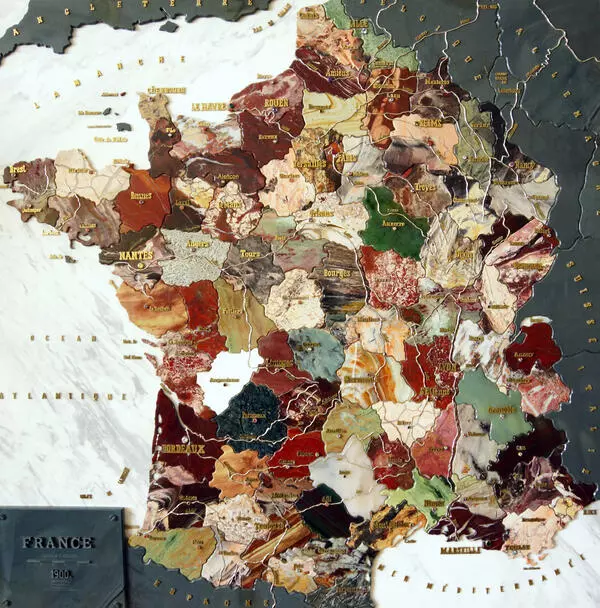Prominent Yekaterinburg stonecutter Anatoly Zhukov created the portrait sculpture of artist-jeweler Alexey Denisov-Uralsky in 2006. The bust made of rock crystal was mounted on a high pedestal made of striped greenish-red jasper. The lower part of the pedestal, the plinth, was made of another kind of jasper, Kalkan. It was mined at the Ural deposit of the same name. This stone, unlike other varieties, has a grayish-green color.
Alexey Denisov was born in 1864 into the family of a hereditary miner, a specialist in extraction and processing of precious stones. Since his early childhood, he watched his father’s work and helped him to decorate paintings and icons with gems and design mineralogical hills. At the age of 18, Denisov and his father presented their works of art at an exhibition in Moscow and won an honorary diploma. The aspiring jeweler dreamed of studying in the capital of Russia, but after the death of his father, he was forced to stay in his native city of Yekaterinburg to take care of his family. In 1884, he was awarded the title of “master of relief”, that is, a specialist in creating decorative images from semi-precious stones. At that time, there were only five artists with such specialization in Yekaterinburg.
In the late 1880s, Alexey Denisov moved to St. Petersburg and entered the Drawing School at the Imperial Society for the Encouragement of Arts. During his studies, he created illustrations for magazines and newspapers and worked as a graphic designer at the Baron Stieglitz School of Technical Drawing. By that time, the jeweler’s works were displayed not only in Russian but also in international exhibitions — in Paris and Copenhagen. In the mid-1890s, Denisov met writer Dmitry Mamin-Sibiryak and, following his example, added to his surname a pseudonym which referred to his place of birth — Uralsky (from the Urals).
By the early 1900s, Alexey Denisov-Uralsky had become such a famous master that his works competed in popularity, price, and quality with the creations of Karl Faberge. Two jewelers jointly worked on some items: for example, Denisov-Uralsky created a stone figure of a bird, and Faberge adorned it with details made of gold and precious stones.
Denisov-Uralsky organized several exhibitions of Ural stones in Moscow and St. Petersburg. For each of them, he compiled detailed descriptions with geographical, historical, and ethnographic explanations. In addition to the works of Ural stonecutters, the visitors could see a model of a tool used for the extraction of topaz, learn how lapidary and jewelry workshops operate, and how gold was washed.
Alexey Denisov was born in 1864 into the family of a hereditary miner, a specialist in extraction and processing of precious stones. Since his early childhood, he watched his father’s work and helped him to decorate paintings and icons with gems and design mineralogical hills. At the age of 18, Denisov and his father presented their works of art at an exhibition in Moscow and won an honorary diploma. The aspiring jeweler dreamed of studying in the capital of Russia, but after the death of his father, he was forced to stay in his native city of Yekaterinburg to take care of his family. In 1884, he was awarded the title of “master of relief”, that is, a specialist in creating decorative images from semi-precious stones. At that time, there were only five artists with such specialization in Yekaterinburg.
In the late 1880s, Alexey Denisov moved to St. Petersburg and entered the Drawing School at the Imperial Society for the Encouragement of Arts. During his studies, he created illustrations for magazines and newspapers and worked as a graphic designer at the Baron Stieglitz School of Technical Drawing. By that time, the jeweler’s works were displayed not only in Russian but also in international exhibitions — in Paris and Copenhagen. In the mid-1890s, Denisov met writer Dmitry Mamin-Sibiryak and, following his example, added to his surname a pseudonym which referred to his place of birth — Uralsky (from the Urals).
By the early 1900s, Alexey Denisov-Uralsky had become such a famous master that his works competed in popularity, price, and quality with the creations of Karl Faberge. Two jewelers jointly worked on some items: for example, Denisov-Uralsky created a stone figure of a bird, and Faberge adorned it with details made of gold and precious stones.
Denisov-Uralsky organized several exhibitions of Ural stones in Moscow and St. Petersburg. For each of them, he compiled detailed descriptions with geographical, historical, and ethnographic explanations. In addition to the works of Ural stonecutters, the visitors could see a model of a tool used for the extraction of topaz, learn how lapidary and jewelry workshops operate, and how gold was washed.
